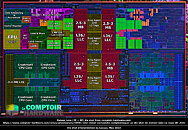- Joined
- Oct 9, 2007
- Messages
- 47,290 (7.53/day)
- Location
- Hyderabad, India
| System Name | RBMK-1000 |
|---|---|
| Processor | AMD Ryzen 7 5700G |
| Motherboard | ASUS ROG Strix B450-E Gaming |
| Cooling | DeepCool Gammax L240 V2 |
| Memory | 2x 8GB G.Skill Sniper X |
| Video Card(s) | Palit GeForce RTX 2080 SUPER GameRock |
| Storage | Western Digital Black NVMe 512GB |
| Display(s) | BenQ 1440p 60 Hz 27-inch |
| Case | Corsair Carbide 100R |
| Audio Device(s) | ASUS SupremeFX S1220A |
| Power Supply | Cooler Master MWE Gold 650W |
| Mouse | ASUS ROG Strix Impact |
| Keyboard | Gamdias Hermes E2 |
| Software | Windows 11 Pro |
Le Comptoir du Hardware scored a die-shot of a 2P+8E core variant of the "Meteor Lake" compute tile, and Locuza annotated it. "Meteor Lake" will be Intel's first processor to implement the company's IDM 2.0 strategy to the fullest. The processor is a multi-chip module of various tiles (chiplets), each with a certain function, sitting on die made on a silicon fabrication node most suitable to that function. Under this strategy, for example, if Intel's chip-designers calculate that the iGPU will be the most power-hungry component on the processor, followed by the CPU cores, the graphics tile will be built on a more advanced process than the compute tile. Intel's "Meteor Lake" and "Arrow Lake" processors will implement chiplets built on the Intel 4, TSMC N3, and Intel 20A fabrication nodes, each with unique power and transistor-density characteristics. Learn more about the "Meteor Lake" MCM in our older article.
The 2P+8E (2 performance cores + 8 efficiency cores) compute tile is one among many variants of compute tiles Intel will develop for the various SKUs making up the next-generation Core mobile processor series. The die is annotated with the two large "Redwood Cove" P-cores and their cache slices taking up about 35% of the die area; and the two "Crestmount" E-core clusters (each with 4 E-cores), and their cache slices, taking up the rest. The two P-cores and two E-core clusters are interconnected by a Ring Bus, and share an L3 cache. The size of each L3 cache slice is either 2.5 MB or 3 MB. At 2.5 MB, the total L3 cache will be 10 MB, and at 3 MB, it will be 12 MB. As with all past generations, the L3 cache is fully accessible by all CPU cores in the compute tile.

Each "Redwood Cove" P-core has 2 MB of dedicated L2 cache, an upgrade from the 1.25 MB on "Golden Cove" P-cores. Intel will make several upgrades to the core to increase IPC over "Golden Cove." Each "Crestmont" E-core cluster sees four "Crestmont" E-cores share a 4 MB L2 cache—double that of the 2 MB in "Gracemont" E-core clusters in "Alder Lake" processors. These cores will feature higher IPC, and probably be able to sustain higher clock speeds; as well as benefit from the larger L2 cache.
The CPU cores and last-level cache are the only identifiable components on the compute die. The rest of it could feature a limited-function Uncore component with the interconnect that binds the various tiles together.
View at TechPowerUp Main Site | Source
The 2P+8E (2 performance cores + 8 efficiency cores) compute tile is one among many variants of compute tiles Intel will develop for the various SKUs making up the next-generation Core mobile processor series. The die is annotated with the two large "Redwood Cove" P-cores and their cache slices taking up about 35% of the die area; and the two "Crestmount" E-core clusters (each with 4 E-cores), and their cache slices, taking up the rest. The two P-cores and two E-core clusters are interconnected by a Ring Bus, and share an L3 cache. The size of each L3 cache slice is either 2.5 MB or 3 MB. At 2.5 MB, the total L3 cache will be 10 MB, and at 3 MB, it will be 12 MB. As with all past generations, the L3 cache is fully accessible by all CPU cores in the compute tile.

Each "Redwood Cove" P-core has 2 MB of dedicated L2 cache, an upgrade from the 1.25 MB on "Golden Cove" P-cores. Intel will make several upgrades to the core to increase IPC over "Golden Cove." Each "Crestmont" E-core cluster sees four "Crestmont" E-cores share a 4 MB L2 cache—double that of the 2 MB in "Gracemont" E-core clusters in "Alder Lake" processors. These cores will feature higher IPC, and probably be able to sustain higher clock speeds; as well as benefit from the larger L2 cache.
The CPU cores and last-level cache are the only identifiable components on the compute die. The rest of it could feature a limited-function Uncore component with the interconnect that binds the various tiles together.
View at TechPowerUp Main Site | Source








